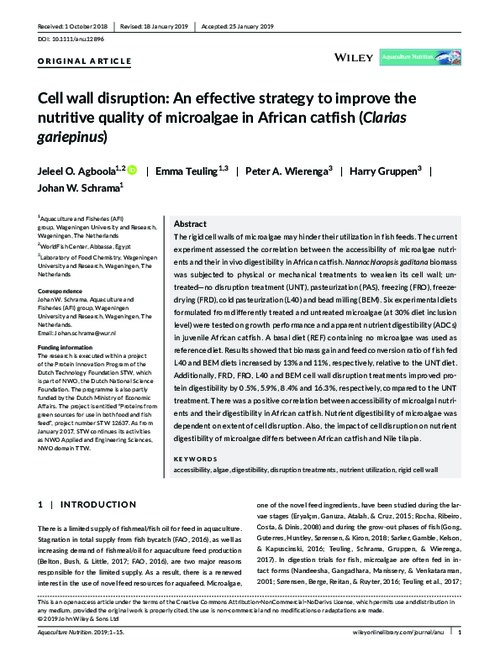Cell wall disruption: An effective strategy to improve the nutritive quality of microalgae in African catfish (Clarias gariepinus)

Citation
Agboola, J. et al. (2019) Cell wall disruption: An effective strategy to improve the nutritive quality of microalgae in African catfish (Clarias gariepinus). Aquaculture Nutrition, 25(4): 783-797.
The rigid cell walls of microalgae may hinder their utilization in fish feeds. The current experiment assessed the correlation between the accessibility of microalgae nutri- ents and their in vivo digestibility in African catfish. Nannochloropsis gaditana biomass was subjected to physical or mechanical treatments to weaken its cell wall; un- treated—no disruption treatment (UNT), pasteurization (PAS), freezing (FRO), freeze- drying (FRD), cold pasteurization (L40) and bead milling (BEM). Six experimental diets formulated from differently treated and untreated microalgae (at 30% diet inclusion level) were tested on growth performance and apparent nutrient digestibility (ADCs) in juvenile African catfish. A basal diet (REF) containing no microalgae was used as reference diet. Results showed that biomass gain and feed conversion ratio of fish fed L40 and BEM diets increased by 13% and 11%, respectively, relative to the UNT diet. Additionally, FRD, FRO, L40 and BEM cell wall disruption treatments improved pro- tein digestibility by 0.5%, 5.9%, 8.4% and 16.3%, respectively, compared to the UNT treatment. There was a positive correlation between accessibility of microalgal nutri- ents and their digestibility in African catfish. Nutrient digestibility of microalgae was dependent on extent of cell disruption. Also, the impact of cell disruption on nutrient digestibility of microalgae differs between African catfish and Nile tilapia.
Permalink
Date Available
Type
Publisher
Countries
ISSN
1353-5773
Copyright
CC-BY-NC-ND-4.0
Research Themes
Language